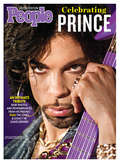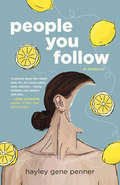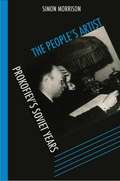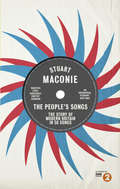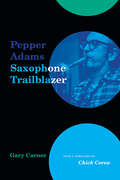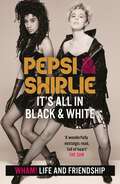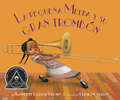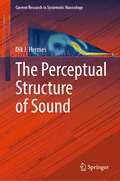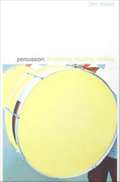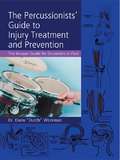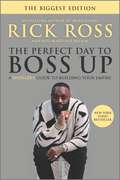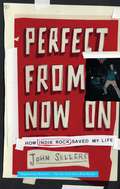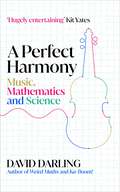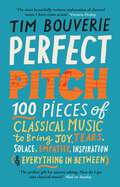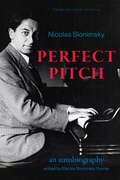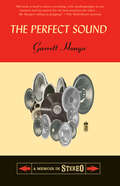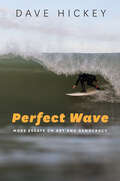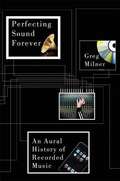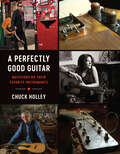- Table View
- List View
PEOPLE Prince
by The Editors of PEOPLEThe editors of PEOPLE Magazine present Prince for PEOPLE Prince.
People You Follow: A Memoir
by Hayley Gene Penner“A journey down the rabbit hole of LA's most subtly toxic industry ... funny, brilliant, coy, playful, and wise.” — LENA DUNHAM, author of Not That Kind of Girl Musician Hayley Gene Penner tells all in this harrowingly honest memoir. Singer-songwriter Hayley Gene Penner's memoir takes a brutally honest yet humorous look at the dark, intimate truths we spend our lives running from. Like a map of beautiful mistakes, Hayley’s stories of questionable sexual encounters, artistic aspirations, and emotional abuse trace her coming of age in the music industry. Hayley explores all her relationships — from her childhood as the daughter of a celebrity, to the destructive and coercive relationship with her boss, to her encounter with the actor we all know but who mustn’t be named — and brings them together in a series of sharp, touching vignettes. People You Follow straddles the delicate boundary between ethical and unethical behaviour, self-protection and self-destruction, power and weakness, giddiness and despair.
The People's Artist: Prokofiev's Soviet Years
by Simon MorrisonSergey Prokofiev was one of the twentieth century's greatest composers--and one of its greatest mysteries. In 1918, he escaped a Russia engulfed in revolution, eventually settling in Paris. Then, in 1936, he surprisingly returned to the increasingly brutal Soviet Union. There he seemed to disappear, the details of his life and work filtered by a security apparatus that kept Prokofiev--and his legacy--under careful guard. Until now. In The People's Artist, Simon Morrison draws on groundbreaking research to illuminate the life of this major composer, offering profound new insight into the master's work. Morrison was the first scholar to gain access to the composer's sealed files in the Russian State Archives, where he uncovered a wealth of previously unknown scores, unexpurgated speeches and writings, correspondence, and unopened journals and diaries. The story he found in these hoarded documents is one of lofty hopes and disillusionment, of personal and creative upheavals. Prokofiev seemed to thrive on uncertainty during his Paris years, stashing scores in suitcases and drafting librettos and scenarios on hotel letterhead. He stunned his fellow émigrés by returning at a time when the All-Union Committee on Arts Affairs took command of all musical activities. At first, Stalin's regime treated him as a celebrity, but Morrison details how the bureaucratic machine ground him down with corrections and censorship (forcing rewrites of such major works as Romeo and Juliet and War and Peace), until it finally censured him in 1948, ending his career and breaking his health. Along the way, the author deftly analyzes Prokofiev's music in light of these archival discoveries. Morrison combines truly groundbreaking research with astute musical analysis to create a stark new image of a great composer. Additionally, Morrison discusses in detail Prokofiev's Fifth, Sixth, and Seventh symphonies, the Ninth piano sonata, the cello sonata, the Violin sonata in d minor and his last complete work, the Sinfonia Concertante. Simon Morrison is Professor of Music at Princeton University. He is the author of Russian Opera and the Symbolist Movement and the editor of Prokofiev and His World. He restored the original, uncensored version of Romeo and Juliet for the Mark Morris Dance Group, which premiered the work in July 2008.
The People’s Songs: The Story of Modern Britain in 50 Records
by Stuart MaconieThese are the songs that we have listened to, laughed to, loved to and laboured to, as well as downed tools and danced to. Covering the last seven decades, Stuart Maconie looks at the songs that have sound tracked our changing times, and – just sometimes – changed the way we feel. Beginning with Vera Lynn’s ‘We’ll Meet Again’, a song that reassured a nation parted from their loved ones by the turmoil of war, and culminating with the manic energy of ‘Bonkers’, Dizzee Rascal’s anthem for the push and rush of the 21st century inner city, The People’s Songs takes a tour of our island’s pop music, and asks what it means to us. This is not a rock critique about the 50 greatest tracks ever recorded. Rather, it is a celebration of songs that tell us something about a changing Britain during the dramatic and kaleidoscopic period from the Second World War to the present day. Here are songs about work, war, class, leisure, race, family, drugs, sex, patriotism and more, recorded in times of prosperity or poverty. This is the music that inspired haircuts and dance crazes, but also protest and social change. The companion to Stuart Maconie’s landmark Radio 2 series, The People’s Songs shows us the power of ‘cheap’ pop music, one of Britain’s greatest exports. These are the songs we worked to and partied to, and grown up and grown old to – from ‘A Whiter Shade of Pale’ to ‘Rehab', ‘She Loves You’ to ‘Star Man’, ‘Dedicated Follower of Fashion’ to ‘Radio Ga Ga’.
Pepper Adams: Saxophone Trailblazer (Excelsior Editions)
by Gary CarnerPepper Adams is more than a definitive biography of Park "Pepper" Adams (1930–1986). The culmination of thirty-seven years of research, it's a fascinating account of Adams's life and times, thanks to colorful vignettes drawn from the author's 250 unpublished conversations with Adams and other esteemed musicians. These candid observations about Adams and his colleagues reveal previously confidential aspects of Adams's complex personality, his many outstanding achievements, and little-known facts about musicians with whom he worked, such as Thad Jones, Miles Davis, Charlie Parker, John Coltrane, Elvin Jones, Charles Mingus, Stan Kenton, Duke Ellington, Bobby Timmons, Wardell Gray, Dizzy Gillespie, Thelonious Monk, and others. Musicians, jazz fans and collectors, and readers who enjoy a hero's journey will be intrigued by Adams's extraordinary intelligence, the extent of his influence, the reverence he commanded, and his struggle to be rewarded as the unique stylist that he was throughout his career. Moreover, readers will be enlivened by the author's unique approach to biography, in which storytelling moves thematically, sometimes in reverse chronological order.
Pepsi & Shirlie - It's All in Black and White: Wham! Life and Friendship
by Pepsi Demacque-Crockett Shirlie KempLondon. Wham! Pop, glitz and glamour. And two girls with stars in their eyes.Our friendship began one windy day in 1982, outside Finsbury Park tube. It was an instant like at first sight. We were on our way to a Wham! rehearsal. Pepsi was the new girl in the band and over a car stereo, a cassette tape and that journey to Bushey we bonded. We had no idea that we were on the first of many journeys together and that soon we'd be travelling all over Europe, Australia, America, China and Japan. Or that no matter where we went, together, we'd find a way to make every exotic destination feel like home.We'd both been teenagers during the seventies – a dreary and difficult decade, especially if you were young in London and you didn't have much money.So, in 1982, anything was possible for us – a pair of twentysomethings who hadn't been to university, who didn't have any money, who dreamt of singing and dancing, but ultimately lived for fun. Everything felt new and life was a question mark. We had no idea what was lying ahead, but we wanted to say yes.What we didn't know was that we were saying yes to a lifetime of connection that has endured whatever we've done, wherever we've been. From the side of the stage to its centre – we have many stories to tell.And it's all here, it's all in black and white.
Pepsi & Shirlie - It's All in Black and White: Wham! Life and Friendship
by Pepsi Demacque-Crockett Shirlie KempLondon. Wham! Pop, glitz and glamour. And two girls with stars in their eyes.Our friendship began one windy day in 1982, outside Finsbury Park tube. It was an instant like at first sight. We were on our way to a Wham! rehearsal. Pepsi was the new girl in the band and over a car stereo, a cassette tape and that journey to Bushey we bonded. We had no idea that we were on the first of many journeys together and that soon we'd be travelling all over Europe, Australia, America, China and Japan. Or that no matter where we went, together, we'd find a way to make every exotic destination feel like home.We'd both been teenagers during the seventies – a dreary and difficult decade, especially if you were young in London and you didn't have much money.So, in 1982, anything was possible for us – a pair of twentysomethings who hadn't been to university, who didn't have any money, who dreamt of singing and dancing, but ultimately lived for fun. Everything felt new and life was a question mark. We had no idea what was lying ahead, but we wanted to say yes.What we didn't know was that we were saying yes to a lifetime of connection that has endured whatever we've done, wherever we've been. From the side of the stage to its centre – we have many stories to tell.And it's all here, it's all in black and white.
La pequeña Melba y su gran trombón: (Little Melba and Her Big Trombone)
by Katheryn Russell-BrownCoretta Scott King Illustrator Award Honor - American Library Association (ALA) NAACP Image Awards Nominee - National Association for the Advancement of Colored People (NAACP)Galardonada con el premio Coretta Scott King Illustrator Honor Award, una biografía de la virtuosa del jazz afroamericana Melba Doretta Liston, una trombonista, compositora y arreglista musical pionera del siglo XX en una época en la que pocas mujeres tocaban instrumentos y formaban parte de la escena del jazz. Recipient of the Coretta Scott King Illustrator Honor award, a biography of African American jazz virtuoso Melba Doretta Liston, a pioneering twentieth-century trombone player, composer, and music arranger at a time when few women played brass instruments and were part of the jazz scene.A los siete años, Melba Doretta Liston se enamoró de un trombón grande y brillante, y pronto aprendió a tocar el instrumento. Cuando era una adolescente, el extraordinario don de Melba para la música la llevó al mundo del jazz. Se unió a una banda dirigida por el trompetista Gerald Wilson y recorrió el país. Superando obstáculos de raza y género, Melba se convirtió en una famosa trombonista y arreglista, transformando ritmos, armonías y melodías en magníficas canciones para todos los grandes del jazz del siglo XX: Randy Weston, Duke Ellington, Count Basie, Billie Holiday y Quincy Jones, por nombrar solo algunos. Rebosante de entusiasmo y la alegría de hacer música, La pequeña Melba y su gran trombón es un maravilloso tributo a un músico pionero y un gran héroe anónimo del jazz. At age seven, Melba Doretta Liston fell in love with a big, shiny trombone, and soon taught herself to play the instrument. By the time she was a teenager, Melba's extraordinary gift for music led her to the world of jazz. She joined a band led by trumpet player Gerald Wilson and toured the country. Overcoming obstacles of race and gender, Melba went on to become a famed trombone player and arranger, spinning rhythms, harmonies, and melodies into gorgeous songs for all the jazz greats of the twentieth century: Randy Weston, Duke Ellington, Count Basie, Billie Holiday, and Quincy Jones, to name just a few. Brimming with ebullience and the joy of making music, Little Melba and Her Big Trombone is a fitting tribute to a trailblazing musician and a great unsung hero of jazz.
The Perceptual Structure of Sound (Current Research in Systematic Musicology #11)
by Dik J. HermesThis book presents a comprehensive review of how acoustic waves are processed by the auditory system into structured sounds such as musical melodies, speech utterances, or environmental sounds. After an introduction, an overview is given of how the ears distribute acoustic information over a large array of frequency channels that contain the auditory information used by the central nervous system to generate a mental image of what is happening around the listener. This process, called auditory scene analysis, consists of two stages. In the first stage, auditory units are formed such as musical tones and speech syllables. Each auditory unit is perceived at a well-defined moment in time, the beat location of that auditory unit. Moreover, from this process of auditory-unit formation, the auditory attributes of these auditory units emerge, such as their timbre, their pitch, their loudness, and their perceived location. Each of these attributes is discussed in the corresponding chapter. In the second stage of auditory scene analysis, auditory-stream formation, the successive auditory units are integrated into auditory streams, i.e., temporally structured sequences of auditory units that are perceived as emanating from one and the same sound source. Examples of such auditory streams are musical melodies and the utterances of one speaker. The temporal structure of an auditory stream, its rhythm, is determined by the beat locations of its auditory units. The role played by the auditory attributes of the consecutive auditory units is discussed. The melodies of musical streams and the intonation contours of spoken utterances emerge from this process. In music, the beats of parallel streams generally fit into a metric pattern, and, depending on harmony, simultaneous tones can be perceived as consonant or dissonant.Finally, the book contains many sound examples including the MATLAB scripts with which they are generated.
Percussion: Drumming, Beating, Striking
by John MowittPercussion is an attempt--in the author's words--to make sense of "senseless beating," to grasp how rhythm makes sense in music and society. Both a scholar and a former professional drummer, John Mowitt forges a striking encounter between cultural studies and new musicology that seeks to lay out the "percussive field" through which beating--specifically the backbeat that defines early rock-and-roll--comes to matter for raced, urban subjects. For Mowitt, percussion is both an experience of embodiment--making contact in and on the skin--and a provocation for critical theory itself. In delimiting the percussive field, he plays drumming off against the musicological account of the beat, the sociological account of shock and the psychoanalytical account of fantasy. In the process he touches on such topics as the separation of slaves and drums in the era of the slave trade, the migration of rural blacks to urban centers of the North, the practice and politics of "rough music," the links between interpellation and possession, the general strike, beating fantasies, and the concept of the "skin ego. " Percussion makes a fresh and provocative contribution to cultural studies, new musicology, the history of the body and critical race theory. It will be of interest to students of cultural studies and critical theory as well as readers with a serious interest in the history of music, rock-and-roll and drumming.
The Percussionists' Guide to Injury Treatment and Prevention: The Answer Guide to Drummers in Pain
by Dr. Darin WorkmanPain and injury are near constant companions for professional musicians. Aching hands, painful joint swelling, back problems, among other ailments were all thought to be part of the price musicians had to pay to be performers. However, thanks to an increasing awareness of both the kinesiology and biology of movement, as well as proper techniques for fostering good performance habits, musicians no longer have to suffer in silence.Perhaps no group of musicians has been more prone to career-threatening injury than percussionists, and the demands for speed, power, control, and endurance are only increasing. Often musicians wait until an injury is so aggravated that it's too late to be fully treated. In almost every case, if the drummer had done some very simple preventative (or early) care, the injury would never have become a serious issue.The Percussionists' Guide to Injury Treatment and Prevention is designed to aid in that early prevention and treatment. Although it is not a substitute for clinical diagnosis or medical care from a trained physician, it can educate the musician as to how the human body works; the role of muscles and skeletal structure in supporting movement; and understanding specifically how to prevent and treat common injuries. The book begins with a general discussion of how the body works and basic prevention concepts. It then covers each specific area of the body (where it hurts), suggesting practical ways to prevent and treat it. Basic anatomy is covered in terms that a musician can understand.For all percussion students and professionals, The Percussionists' Guide to Injury Treatment and Prevention will be an indispensable companion.
The Perfect Day to Boss Up: A Hustler's Guide To Building Your Empire
by Rick RossA captivating and inspiring guide to building an untouchable empire from mud to marble, no matter what obstacles stand in the wayRick Ross is a hip-hop icon and a towering figure in the business world, but his path to success was not always easy. Despite adversity and setbacks, Ross held tight to his vision and never settled for anything less than greatness. Now, for the first time, he shares his secrets to success, offering his own life as a road map to readers looking to build their own empire. Along the way he reveals: How to turn your ambition into action Tips for managing and investing your money Inside stories from his business and music ventures Why failure is central to success Secrets to handling stressful situations How to build the perfect team As Ross explains, &“It doesn&’t matter what&’s going on. Even the most dire situation is just another opportunity to boss up.&”Intimate, insightful and brimming with no-nonsense advice, The Perfect Time to Boss Up is the ideal book for hustlers everywhere.
Perfect From Now On: How Indie Rock Saved My Life
by John SellersTOP FIVE MUSICAL THINGS I HOPE HAPPEN NOW THAT THE ORIGINAL LINEUPS OF THE PIXIES AND DINOSAUR JR. HAVE REUNITED1. Ian Curtis is resurrected. 2. The Smiths reunite for a private party at my favorite bar. 3. There is a new My Bloody Valentine album. 4. A new Nirvana comes along to blow away all of those fey Duran Duran emulators. 5. Radiohead stops listening to Pink Floyd and starts listening to Black Sabbath. If you've ever made, or conceived of, a list like this, then look no further for your next book purchase. You have it. In your hands. Please consider it as your next book purchase. In Perfect From Now On, John Sellers has written a fan's memoir overflowing with humor, self-deprecation, encyclopedic knowledge of musical minutiae, and "you should have been there" personal anecdotes. Despite vowing never to get caught up in music due to the nuttiness of a Dylan-obsessed father and playground taunts about his preference for Top 40 trash, he found himself powerless to resist the allure of indie rock, the genre that begat the likes of Sonic Youth, Pavement, Built to Spill, and Modest Mouse. When his favorite band, Guided By Voices, called it quits in 2004, Sellers examined his own listening habits, caught a few mind-blowing shows, got drunk with his heroes, and wrote this book -- one that is sure to resonate with anybody who has ever obsessed over good music.
A Perfect Harmony: Music, Mathematics and Science
by David DarlingFrom the earliest of civilisations, humans have found ways to make music, whether through makeshift drums or artfully drilled bone flutes. But how did music – effectively little more than a series of certain tones and rhythms – become so integral to the human experience? Untangling the curious links between notes and number, musical perception, psychology and physics, David Darling examines the fascinating science behind music, from its Palaeolithic origins to the present. Revealing surprising connections and busting pervasive myths, A Perfect Harmony asks: Why do musicians tend to be better at maths than non-musicians? Why do we find some pieces sad and others happy? Will playing Mozart to babies predispose them to genius? Could an AI write the perfect symphony?
Perfect Pitch: 100 pieces of classical music to bring joy, tears, solace, empathy, inspiration (& everything in between)
by Tim Bouverie'If you want to understand classical music but don't know where to start, this is the perfect introduction'. - Alan Titchmarsh'A treat from the very first page... written with style and humour, this is a perfect introduction to classical music for a beginner, a companion for the music lover, and sheer entertainment for both.' - Joanna Lumley'Thank you to Tim Bouverie for this book which can be enjoyed as much by the hard-nosed professional as the beginner, anxious to learn something of this great music.' - Jools HollandNearly all of us have the capacity to enjoy classical music but too often we are put off by not knowing where to look, or what we are actually looking for. We feel the need of a guide to help navigate such vast and varied artistic terrain.With this delightful book, historian Tim Bouverie provides just this. Drawing on his lifelong passion for music, he has created a compilation of 100 classical masterpieces sure to move and be enjoyed by almost anyone. Some are well-known, some more idiosyncratic, others hidden gems waiting to be brought into the light. All are intended to comfort and inspire. He provides a short introduction to each piece - variously anecdotal, personal, historical and quirky - and a recommended recording to try.Highly accessible and entertaining, Perfect Pitch is filled with engrossing stories and insights that bring to life 300 years of the world's greatest music.An accompanying playlist is available on Spotify.'The most beautifully written explanation of classical music I have come across. I was totally enchanted by it... Each short introduction left me eager to hear the music itself.' - Victoria Hislop'Generous and passionate... Tim Bouverie's selection of music is wide-ranging, and his introductions to each piece astutely blend context and anecdote, always delivered with smiling and enthusiastic authority.' - Dame Jane Glover, conductor and author of Mozart's Women'You are new to classical music? I can think of no better introduction. Already know your classical music? I can think of no better companion, no more rewarding way of extending your own knowledge.' - John Suchet, Classic FM'A wonderful selection of music that nourishes the soul, giving comfort as well as joy. Both witty and profound, this is a book which provides insight into life as well as art.' - Julia Samuels, author of Grief Works and This Too Shall Pass
Perfect Pitch: 100 pieces of classical music to bring joy, tears, solace, empathy, inspiration (& everything in between)
by Tim Bouverie'Sharply insightful and vividly imaginative... the perfect Christmas gift for anyone asking: 'How do I get into classical music?'' - Rupert Christiansen, Mail on Sunday'A treat from the very first page... written with style and humour, this is a perfect introduction to classical music for a beginner, a companion for the music lover, and sheer entertainment for both.' - Joanna LumleyNearly all of us have the capacity to enjoy classical music but too often we are put off by not knowing where to look, or what we are actually looking for. We feel the need of a guide to help navigate such vast and varied artistic terrain.With this delightful book, historian Tim Bouverie provides just this. Drawing on his lifelong passion for music, he has created a compilation of 100 classical masterpieces sure to move and be enjoyed by almost anyone. Some are well-known, some more idiosyncratic, others hidden gems waiting to be brought into the light. All are intended to comfort and inspire. He provides a short introduction to each piece - variously anecdotal, personal, historical and quirky - and a recommended recording to try.Highly accessible and entertaining, Perfect Pitch is filled with engrossing stories and insights that bring to life 300 years of the world's greatest music.An accompanying playlist is available on Spotify.
Perfect Pitch, Third Revised Edition: An Autobiography (Excelsior Editions)
by Nicolas SlonimskyPerfect Pitch tells the compelling story of Nicolas Slonimsky. A boy prodigy as a pianist, Slonimsky fled pre-Communist Russia, reaching Paris at the height of another revolution—one in music and the arts. His early association with conductor Serge Koussevitzky brought him into contact with many of the era's greatest talents, including Igor Stravinsky and Serge Prokofiev. Emigrating to Boston in 1925, he embarked on a writing career, authoring key works still in print decades after their first publication, including Music Since 1900, a chronological history; Lexicon of Musical Invective, which proved definitively that new works are rarely understood in their time; and Thesaurus of Scales and Melodic Patterns, which inspired generations of composers and performers, including jazz saxophonist John Coltrane. Known for his sharp wit, Slonimsky appeared on The Tonight Show with Johnny Carson and was befriended by Frank Zappa. Perfect Pitch captures a life that was rich with discovery and invention and spanned a century of revolutions and explorations. This new edition is enhanced with several previously unpublished photographs, an extensive oral history, and several original essays, some reprinted for the first time.
The Perfect Sound: A Memoir in Stereo
by Garrett HongoGarrett Hongo’s passion for audio dates back to the Empire 398 turntable his father paired with a Dynakit tube amplifier in their modest tract home in Los Angeles in the early 1960s. But his adult quest begins in the CD-changer era, as he seeks out speakers and amps both powerful and refined enough to honor the top notes of the greatest opera sopranos. In recounting this search, he describes a journey of identity where meaning, fulfillment, and even liberation were often most available to him through music and its astonishingly varied delivery systems. <p><p> Hongo writes about the sound of surf being his first music as a kid in Hawai‘i, about doo-wop and soul reaching out to him while growing up among Black and Asian classmates in L.A., about Rilke and Joni Mitchell as the twin poets of his adolescence, and about feeling the pulse of John Coltrane’s jazz and the rhythmic chords of Billy Joel’s piano from his car radio while driving the freeways as a young man trying to become a poet. <p><p> Journeying further, he visits devoted collectors of decades-old audio gear as well as designers of the latest tube equipment, listens to sublime arias performed at La Scala, hears a ghostly lute at the grave of English Romantic poet John Keats in Rome, drinks in wisdom from blues musicians and a diversity of poetic elders while turning his ear toward the memory-rich strains of the music that has shaped him: Hawaiian steel guitar and canefield songs; Bach and the Band; Mingus, Puccini, and Duke Ellington. And in the decades-long process of perfecting his stereo setup, Hongo also discovers his own now-celebrated poetic voice.
Perfect Sound Whatever: THE SUNDAY TIMES BESTSELLER
by James Acaster*The Sunday Times Bestseller*The brand new memoir from James Acaster: cult comedian, bestselling author of Classic Scrapes, undercover cop, receiver of cabbages.PERFECT SOUND WHATEVER is a love letter to the healing power of music, and how one man's obsessive quest saw him defeat the bullshit of one year with the beauty of another. Because that one man is James Acaster, it also includes tales of befouling himself in a Los Angeles steakhouse, stealing a cookie from Clint Eastwood, and giving drunk, unsolicited pep talks to urinating strangers. January, 2017James Acaster wakes up heartbroken and alone in New York, his relationship over, a day of disastrous meetings leading him to wonder if comedy is really what he wants to be doing any more. A constant comfort in James's life has been music, but he's not listened to anything new for a very long time. Idly browsing 'best of the year' lists, it dawns on him that 2016 may have been a grim year for a lot of reasons, but that it seemed to be an iconic year for music. And so begins a life-changing musical odyssey, as James finds himself desperately seeking solace in the music of 2016, setting himself the task of only listening to music released that year, ending up with 500 albums in his collection. Looking back on this year-long obsession, parallels begin to grow between the music and James's own life: his relationship history, the highs and lows of human connection, residual Christian guilt, and mental health issues that have been bubbling under the surface for years. Some albums are life-changing masterpieces, others are 'Howdilly Doodilly' by Okilly Dokilly, a metalcore album devoted to The Simpsons' character Ned Flanders, but all of them play a part the year that helped James Acaster get his life back on track.
Perfect Sound Whatever: THE SUNDAY TIMES BESTSELLER
by James Acaster*The Sunday Times Bestseller*The brand new memoir from James Acaster: cult comedian, bestselling author of Classic Scrapes, undercover cop, receiver of cabbages.PERFECT SOUND WHATEVER is a love letter to the healing power of music, and how one man's obsessive quest saw him defeat the bullshit of one year with the beauty of another. Because that one man is James Acaster, it also includes tales of befouling himself in a Los Angeles steakhouse, stealing a cookie from Clint Eastwood, and giving drunk, unsolicited pep talks to urinating strangers. January, 2017James Acaster wakes up heartbroken and alone in New York, his relationship over, a day of disastrous meetings leading him to wonder if comedy is really what he wants to be doing any more. A constant comfort in James's life has been music, but he's not listened to anything new for a very long time. Idly browsing 'best of the year' lists, it dawns on him that 2016 may have been a grim year for a lot of reasons, but that it seemed to be an iconic year for music. And so begins a life-changing musical odyssey, as James finds himself desperately seeking solace in the music of 2016, setting himself the task of only listening to music released that year, ending up with 500 albums in his collection. Looking back on this year-long obsession, parallels begin to grow between the music and James's own life: his relationship history, the highs and lows of human connection, residual Christian guilt, and mental health issues that have been bubbling under the surface for years. Some albums are life-changing masterpieces, others are 'Howdilly Doodilly' by Okilly Dokilly, a metalcore album devoted to The Simpsons' character Ned Flanders, but all of them play a part the year that helped James Acaster get his life back on track.
Perfect Sound Whatever: THE SUNDAY TIMES BESTSELLER
by James AcasterThe brand new memoir from James Acaster: cult comedian, bestselling author of Classic Scrapes, undercover cop, receiver of cabbages.PERFECT SOUND WHATEVER is a love letter to the healing power of music, and how one man's obsessive quest saw him defeat the bullshit of one year with the beauty of another. Because that one man is James Acaster, it also includes tales of befouling himself in a Los Angeles steakhouse, stealing a cookie from Clint Eastwood, and giving drunk, unsolicited pep talks to urinating strangers. January, 2017James Acaster wakes up heartbroken and alone in New York, his relationship over, a day of disastrous meetings leading him to wonder if comedy is really what he wants to be doing any more. A constant comfort in James's life has been music, but he's not listened to anything new for a very long time. Idly browsing 'best of the year' lists, it dawns on him that 2016 may have been a grim year for a lot of reasons, but that it seemed to be an iconic year for music. And so begins a life-changing musical odyssey, as James finds himself desperately seeking solace in the music of 2016, setting himself the task of only listening to music released that year, ending up with 500 albums in his collection. Looking back on this year-long obsession, parallels begin to grow between the music and James's own life: his relationship history, the highs and lows of human connection, residual Christian guilt, and mental health issues that have been bubbling under the surface for years. Some albums are life-changing masterpieces, others are 'Howdilly Doodilly' by Okilly Dokilly, a metalcore album devoted to The Simpsons' character Ned Flanders, but all of them play a part the year that helped James Acaster get his life back on track.
Perfect Tunes
by Emily GouldThe perfect song. The biggest dream. The love of her life. It’s the early days of the new millennium, and Laura has arrived in New York City’s East Village in the hopes of recording her first album. A songwriter with a one-of-a-kind talent, she’s just beginning to book gigs with her beautiful best friend when she falls hard for a troubled but magnetic musician whose star is on the rise. Their time together is stormy and short-lived – but will reverberate for the rest of Laura’s life. Fifteen years later, Laura’s teenage daughter is asking questions about her father, questions Laura does not want to answer. Laura has built a stable life in Brooklyn that bears little resemblance to the one she envisioned all those years ago, and she’s taken pains to close the door on what was and what might have been. When her best friend – now a famous musician – comes to town, opportunity knocks for Laura for a second time. Has growing older changed who she is and what she most wants? After all the sacrifices and compromises she’s made along the way, how much is she still that girl from Ohio, with big talent and big dreams?Funny, wise and tender-hearted, Perfect Tunes explores the fault lines in our most important relationships, and asks whether dreams deferred can ever be reclaimed. Praise for Emily Gould 'Emily Gould is massively talented, just as good at devastating us with an emotional truth as she is at amusing us with a clever joke' Curtis Sittenfeld ‘Emily Gould recreates with wit and insight the New York I know: a place full of fame and money that's not yours, where friends become family and lovers become ex-lovers, and the big questions about your life stay unanswered, and unanswerable, for a long time’ Chad Harbach 'A sharp study of female friendship, that treacherous terrain where envy and deep fondness often go hand in hand' Observer ‘A wry, sharply observed coming-of-age story for the post-recession era’ People&‘A vivid exploration of the missed connections and overwhelming isolation of modern urban life . . . Compulsively readable’ Los Angeles Times ‘It points to Ms Gould's abilities as a keen-eyed noticer and her knack for nailing down her ravenous observations with energy and flair’ New York Times
Perfect Wave: More Essays on Art and Democracy
by Dave HickeyWhen Dave Hickey was twelve, he rode the surfer’s dream: the perfect wave. And, like so many things in life we long for, it didn’t quite turn out----he shot the pier and dashed himself against the rocks of Sunset Cliffs in Ocean Beach, which just about killed him. Fortunately, for Hickey and for us, he survived, and continues to battle, decades into a career as one of America’s foremost critical iconoclasts, a trusted, even cherished no-nonsense voice commenting on the all-too-often nonsensical worlds of art and culture. Perfect Wave brings together essays on a wide range of subjects from throughout Hickey’s career, displaying his usual breadth of interest and powerful insight into what makes art work, or not, and why we care. With Hickey as our guide, we travel to Disneyland and Vegas, London and Venice. We discover the genius of Karen Carpenter and Waylon Jennings, learn why Robert Mitchum matters more than Jimmy Stewart, and see how the stillness of Antonioni speaks to us today. Never slow to judge—or to surprise us in doing so—Hickey powerfully relates his wincing disappointment in the later career of his early hero Susan Sontag, and shows us the appeal to our commonality that we’ve been missing in Norman Rockwell. With each essay, the doing is as important as what’s done; the pleasure of reading Dave Hickey lies nearly as much in spending time in his company as in being surprised to find yourself agreeing with his conclusions. Bookended by previously unpublished personal essays that offer a new glimpse into Hickey’s own life—including the aforementioned slam-bang conclusion to his youthful surfing career—Perfect Wave is not a perfect book. But it’s a damn good one, and a welcome addition to the Hickey canon.
Perfecting Sound Forever: An Aural History of Recorded Music
by Greg MilnerIN 1915, THOMAS EDISON PROCLAIMED THAT HE COULD RECORD A LIVE PERFORMANCE and reproduce it perfectly, shocking audiences who found themselves unable to tell whether what they were hearing was an Edison Diamond Disc or a flesh-and-blood musician. Today, the equation is reversed. Whereas Edison proposed that a real performance could be rebuilt with absolute perfection, Pro Tools and digital samplers now allow musicians and engineers to create the illusion of performances that never were. In between a century of sonic exploration into the balance between the real and the represented! Tracing the contours of this history,-Greg Milner fakes us through the major breakthroughs and glorious failures in the art and science of recording. An American soldier monitoring Nazi radio transmissions stumbles onto the open yet revolutionary secret of magnetic tape, Japanese and Dutch researchers build a first-generation digital audio format and watch as their "compact disc” is marketed by the music industry as the second coming of Edison yet derided as heretical by analog loyalists. The music world becomes addicted to volume in the nineties and fights a self-defeating "loudness war" to get its fix. From Les Paul to Phil Spector to King Tubby, from vinyl to pirated CDs to iPods, Milner pulls apart musical history to answer a crucial question: Should a recording document reality as faithfully as possible, or should it improve upon or somehow transcend the music it records? The answers he uncovers will change the very way we think about music.
A Perfectly Good Guitar: Musicians on Their Favorite Instruments
by Chuck HolleyAsk guitar players about their instruments, and you&’re likely to get a story—where the guitar came from, or what makes it unique, or why the player will never part with it. Most guitarists have strong feelings about their primary tool, and some are downright passionate about their axes. Chuck Holley is a professional photographer and writer who loves music and listening to musicians talk about their trade. For several years, he has been photographing guitarists with their prized instruments and collecting their stories. This beautifully illustrated book presents these stories in revelatory photographs and words. The guitarists included in this book range from high-profile performers, including Rosanne Cash, Guy Clark, Laurence Juber, Jorma Kaukonen, JD Souther, Bill Frisell, Dave Alvin, and Kelly Willis, to renowned studio musicians and band members. Holley&’s beautifully composed photographs portray them with their favorite guitar, including detail shots of the instrument. Accompanying the photographs are the musicians&’ stories about the Gibsons, Fenders, Martins, and others that have become the guitar in their lives, the one that has a special lineage or intangible qualities of sustain, tone, clarity, and comfort that make it irreplaceable. Several musicians talk about how the guitar chose them, while others recount stories of guitars lost or stolen and then serendipitously recovered. Together, these photographs and stories underscore the great pleasure of performing with an instrument that&’s become a trusted friend with a personality all its own.
